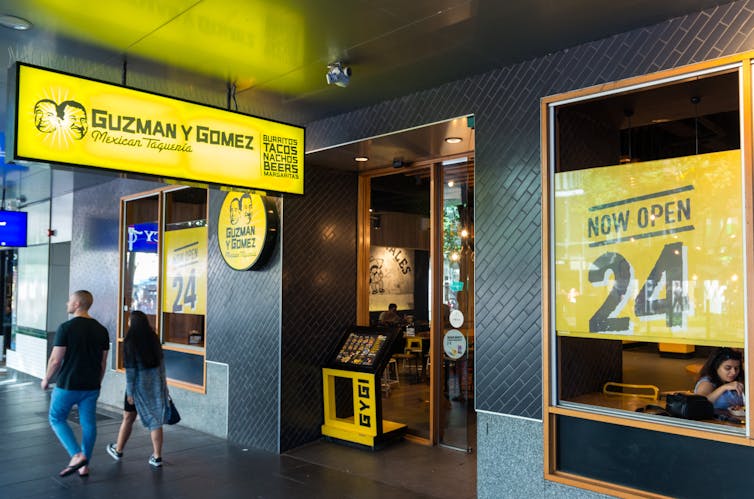This article is part of The Conversation’s “Business Basics” series where we ask leading experts to discuss key concepts in business, economics and finance.
Popular Australian fast-food chain Guzman y Gomez has announced it will undergo an initial public offering or “IPO” later this month, listing itself on the Australian Stock Exchange (ASX). The move will value the company at A$2.2 billion.
An IPO – sometimes also called a company float – signifies the first time that a privately owned company lists its shares on a public stock exchange.
But it’s an expensive process, which also allows public investors to “look at the books” and scrutinise a company’s financial performance in detail.
So how do IPOs work, and why do companies do them?
Most companies are private, but all technically have shares
All companies technically have “shares”. These simply represent a stake of ownership in a company and its profits. A company might have one shareholder with a single 100% share, or thousands of them, all holding different percentages of the company.
The vast majority of companies are privately held, meaning their shares can’t be traded without private negotiations. When a company goes public, it means that anyone can now easily trade shares in it at their market price by placing an order on a stock exchange.

At a high level, the price of a share represents the relevant fraction of all future cash flows a company is expected to generate, expressed in terms of their value today (what we call a present value). We can’t know the future, so the value of a share changes as these expectations change.
While an IPO represents the first time a company’s shares become available for trading by the public, the majority of those shares typically already exist.
For example, Guzman y Gomez’s IPO prospectus (a heavily detailed report that to-be-listed companies are required to publish) says the company will have about 101.3 million shares on issue after the IPO. But this is only about 10% more than already currently exist.
Why do it?
Being a public company isn’t easy – it attracts the full scrutiny of a market of public investors that’s often criticised as being short-sighted and overly sensitive to short-term fluctuations in performance. So why float at all?
Asking chief financial officers who’ve been through the process typically reveals some common themes.
Near the top of the list, an IPO helps a company establish an accurate market price for itself.

An unlisted company might have a pretty good idea as to what its assets are worth. But it’s not until it falls under the fickle lens of market scrutiny that it receives a more objective – and sometimes alarming – assessment of its true value.
One big benefit of knowing what a company is worth, and issuing new shares based on that valuation, is that its original owners can sell some of their shares through the offering.
This has twin benefits. It enables them to convert previously hard-to-sell company shares into cash, and provides the opportunity to diversify their personal investment portfolios.
But being listed also provides a firm with superior access to new sources of cash. It gets to enjoy some of these benefits immediately by fundraising in the IPO – selling shares to new investors. But the more rigorous disclosure regime under which listed companies have to operate also means the firm will likely benefit from better access to debt (such as corporate bonds) and equity (shares) markets in the future.
Looking a little more aggressively down the corporate track, a listed company might eventually want to acquire other firms. Being listed means a firm can use its publicly traded shares instead of cash to make an offer for another company, which is called a “scrip bid”.
Many of these common benefits are relevant to the case of Guzman y Gomez’s IPO, which is expected to raise $242.5 million by issuing 11.1 million shares.
About $42.5 million of these funds will go to existing shareholders cashing out their investment. The remaining $200 million raised is expected to be divided between covering the costs of the IPO ($17.4 million) and funding future expansion of the restaurant network in Australia and possibly internationally.

The process isn’t cheap or easy
You can see that IPOs aren’t cheap transactions, with almost 9% of the $200 million raised being paid to various managers and advisers to the float.
So what does the firm get in return for their money? Two joint lead managers have been engaged on the Guzman y Gomez float – investment banks Barrenjoey Markets and Morgan Stanley.
To date, these firms will have delivered a lot of hands-on practical advice about structuring the deal – such as how to determine the number of shares available for sale to institutions, broker firms, employees and franchisees.
But crucially, they also advise on the offer price for those shares. Remember, Guzman y Gomez is in the Mexican food business, not the IPO business, so it is heavily reliant on its investment banking team to help set an appropriate price.
Set it too high and the shares may remain unsold. Too low, and the company will have “left money on the table” by passing up the opportunity to sell shares at their full value.
Fortunately, the leadership of Guzman y Gomez can get some sleep in the run-up to the listing. The joint managing investment banks have agreed, for a fee, to underwrite the deal, which means that they will step in and buy shares at a set price if any offered don’t sell.
But that’s not to say it’s all stress free. While the subscription price of the new shares has been set – and guaranteed – at $22 per share, this does not necessarily mean the share will continue to trade at $22 after it’s listed.
In Australia’s biggest IPO last year, chemical distributor Redox issued shares at $2.55, valuing it at $1.3 billion. But by the end of the first day, prices had fallen by about 5%.
That’s the great thing about public markets. You’ll get transparent objective feedback from day one, whether you like it or not!

